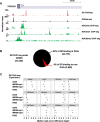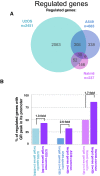Role of the chromatin landscape and sequence in determining cell type-specific genomic glucocorticoid receptor binding and gene regulation
- PMID: 27903902
- PMCID: PMC5389550
- DOI: 10.1093/nar/gkw1163
Role of the chromatin landscape and sequence in determining cell type-specific genomic glucocorticoid receptor binding and gene regulation
Abstract
The genomic loci bound by the glucocorticoid receptor (GR), a hormone-activated transcription factor, show little overlap between cell types. To study the role of chromatin and sequence in specifying where GR binds, we used Bayesian modeling within the universe of accessible chromatin. Taken together, our results uncovered that although GR preferentially binds accessible chromatin, its binding is biased against accessible chromatin located at promoter regions. This bias can only be explained partially by the presence of fewer GR recognition sequences, arguing for the existence of additional mechanisms that interfere with GR binding at promoters. Therefore, we tested the role of H3K9ac, the chromatin feature with the strongest negative association with GR binding, but found that this correlation does not reflect a causative link. Finally, we find a higher percentage of promoter-proximal GR binding for genes regulated by GR across cell types than for cell type-specific target genes. Given that GR almost exclusively binds accessible chromatin, we propose that cell type-specific regulation by GR preferentially occurs via distal enhancers, whose chromatin accessibility is typically cell type-specific, whereas ubiquitous target gene regulation is more likely to result from binding to promoter regions, which are often accessible regardless of cell type examined.
© The Author(s) 2016. Published by Oxford University Press on behalf of Nucleic Acids Research.
Figures







Similar articles
-
Different chromatin and DNA sequence characteristics define glucocorticoid receptor binding sites that are blocked or not blocked by coregulator Hic-5.PLoS One. 2018 May 8;13(5):e0196965. doi: 10.1371/journal.pone.0196965. eCollection 2018. PLoS One. 2018. PMID: 29738565 Free PMC article.
-
C/EBP maintains chromatin accessibility in liver and facilitates glucocorticoid receptor recruitment to steroid response elements.EMBO J. 2013 May 29;32(11):1568-83. doi: 10.1038/emboj.2013.106. Epub 2013 May 10. EMBO J. 2013. PMID: 23665916 Free PMC article.
-
Genome-Wide Identification of Basic Helix-Loop-Helix and NF-1 Motifs Underlying GR Binding Sites in Male Rat Hippocampus.Endocrinology. 2017 May 1;158(5):1486-1501. doi: 10.1210/en.2016-1929. Endocrinology. 2017. PMID: 28200020 Free PMC article.
-
Genomic effects of glucocorticoids.Protoplasma. 2017 May;254(3):1175-1185. doi: 10.1007/s00709-016-1063-y. Epub 2016 Dec 24. Protoplasma. 2017. PMID: 28013411 Review.
-
Chromatin architecture defines the glucocorticoid response.Mol Cell Endocrinol. 2013 Nov 5;380(1-2):25-31. doi: 10.1016/j.mce.2013.03.020. Epub 2013 Mar 29. Mol Cell Endocrinol. 2013. PMID: 23545159 Free PMC article. Review.
Cited by
-
Expanding the repertoire of glucocorticoid receptor target genes by engineering genomic response elements.Life Sci Alliance. 2019 Mar 13;2(2):e201800283. doi: 10.26508/lsa.201800283. Print 2019 Apr. Life Sci Alliance. 2019. PMID: 30867223 Free PMC article.
-
DNA methylation as a pharmacodynamic marker of glucocorticoid response and glioma survival.Nat Commun. 2022 Sep 20;13(1):5505. doi: 10.1038/s41467-022-33215-x. Nat Commun. 2022. PMID: 36127421 Free PMC article.
-
Molecular mechanisms contributing to glucocorticoid resistance in lymphoid malignancies.Cancer Drug Resist. 2019 Sep 19;2(3):647-664. doi: 10.20517/cdr.2019.29. eCollection 2019. Cancer Drug Resist. 2019. PMID: 35582582 Free PMC article. Review.
-
Different chromatin and DNA sequence characteristics define glucocorticoid receptor binding sites that are blocked or not blocked by coregulator Hic-5.PLoS One. 2018 May 8;13(5):e0196965. doi: 10.1371/journal.pone.0196965. eCollection 2018. PLoS One. 2018. PMID: 29738565 Free PMC article.
-
Therapeutic glucocorticoids: mechanisms of actions in rheumatic diseases.Nat Rev Rheumatol. 2020 Mar;16(3):133-144. doi: 10.1038/s41584-020-0371-y. Epub 2020 Feb 7. Nat Rev Rheumatol. 2020. PMID: 32034322 Review.
References
-
- Siersbaek R., Rabiee A., Nielsen R., Sidoli S., Traynor S., Loft A., La Cour Poulsen L., Rogowska-Wrzesinska A., Jensen O.N., Mandrup S.. Transcription factor cooperativity in early adipogenic hotspots and super-enhancers. Cell Rep. 2014; 7:1443–1455. - PubMed
-
- Jolma A., Yin Y., Nitta K.R., Dave K., Popov A., Taipale M., Enge M., Kivioja T., Morgunova E., Taipale J.. DNA-dependent formation of transcription factor pairs alters their binding specificity. Nature. 2015; 527:384–388. - PubMed
Publication types
MeSH terms
Substances
LinkOut - more resources
Full Text Sources
Other Literature Sources

